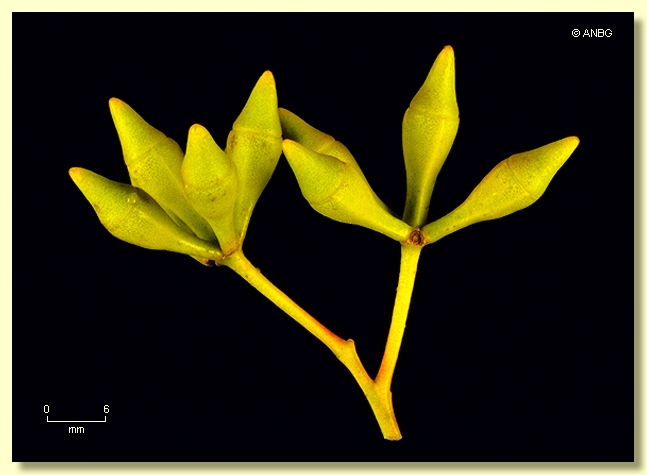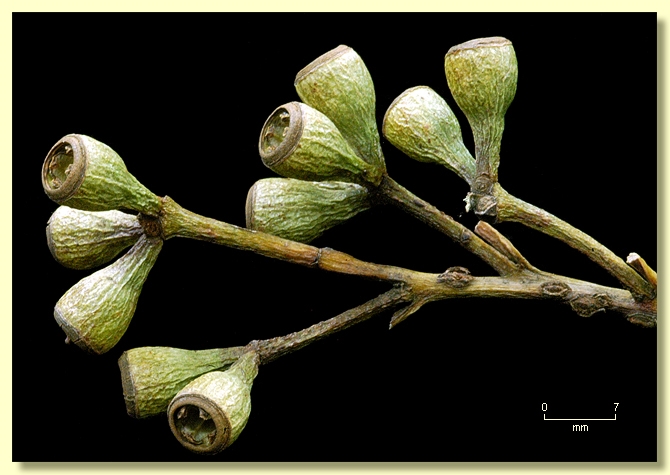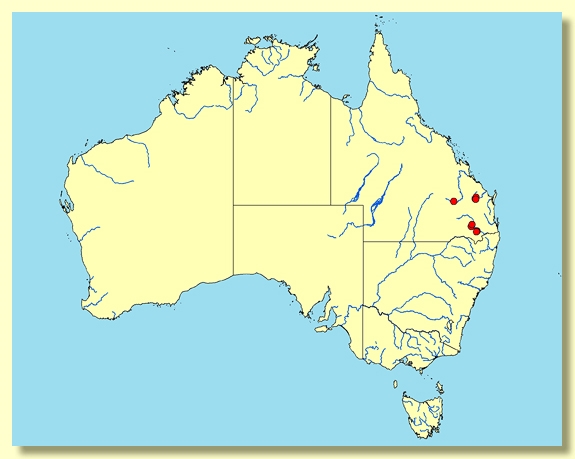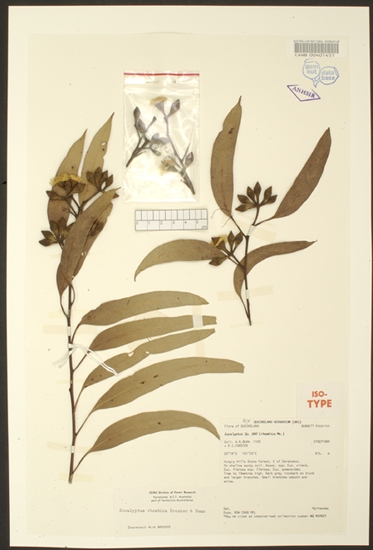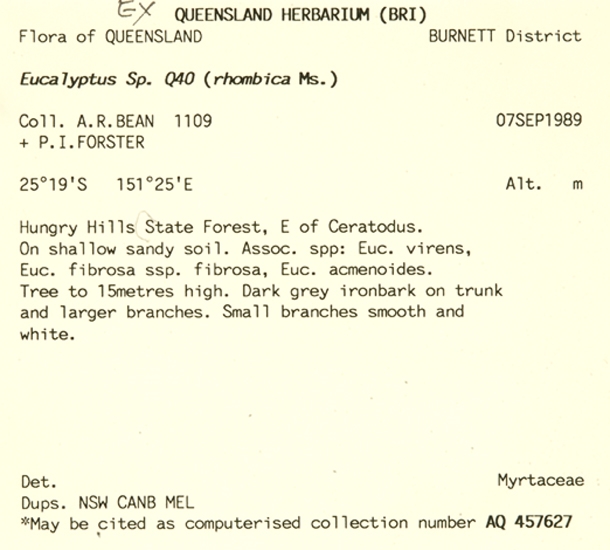Eucalyptus | Symphyomyrtus | Adnataria | Apicales | Siderophloiae | Subglaucae
Euclid - Online edition
Eucalyptus rhombica
Tree to 20 m tall. Forming a lignotuber.
Ironbark to small branches, grey or black, sometimes smooth-barked on branches smaller than 12 cm diameter.
Juvenile growth (coppice or field seedlings to 50 cm): stems square or round in cross-section; juvenile leaves always petiolate, alternate, ovate to broadly lanceolate, 6.5–10(15) cm long, 2–3 cm wide, base tapering to petiole, slightly discolorous, dull, bluish-green.
Adult leaves alternate, petiole 1.5–2.7 cm long; blade lanceolate to broadly lanceolate to falcate, 9–15 (23) cm long, 1.5–3.5 cm wide, base tapering to petiole, concolorous, dull or rarely glossy, grey-green, side-veins usually greater than 45° to midrib, densely to very densely reticulate, intramarginal vein parallel to and just within margin, oil glands sparse and mostly intersectional.
Inflorescence terminal compound and sometimes axillary single umbels also, peduncles 1–2.5 cm long, buds usually 7 per umbel, pedicels 0.5–1 cm long. Mature buds diamond-shaped, sometimes with four longitudinal ridges on the hypanthium, 0.8–1.4 cm long, 0.5–0.6 cm wide, scar present, operculum conical, sometimes slightly beaked, stamens irregularly flexed, anthers adnate, cuboid, dehiscing by lateral pores or slits, style long, stigma blunt, locules usually 4, the placentae each with 4 vertical ovule rows. Flowers white.
Fruit on pedicels 0.3–0.9 cm long, cup-shaped or obconical, 0.7–1 cm long, 0.7–0.1 cm wide, disc descending, valves usually 4, near rim level.
Seeds brown, 1.5–2 (2.2) mm long, ovoid or flattened-ovoid, dorsal surface smooth or shallowly pitted, hilum ventral.
Cultivated seedlings (measured at ca node 10): cotyledons oblong to reniform; stems square in cross-section; leaves always petiolate, opposite for 2 or 3 nodes then alternate, leaves on lower stem ovate to broadly lanceolate, becoming narrower further up the stem, 6.5–10 cm long, 1.4–3.6 cm wide, base tapering, apex pointed, margin entire, discolorous, dull blue-green above, paler beneath.
Flowering has been recorded in January, March, September and November.
A small to medium-sized ironbark tree restricted to three areas in south-east Queensland, from the Leyburn – Cecil Plains – Milmerran area just west of Toowoomba, the Binjour Plateau State Forest near Gayndah and the area just west of Taroom. Characterised by its relatively large diamond-shaped buds with all stamens fertile and its relatively large obconical to cup-shaped fruit to 1 cm wide.
Eucalyptus rhombica is closely related to E. siderophloia. Both species have diamond-shaped buds, obconical to cup-shaped fruit and ovate to broadly lanceolate juvenile leaves. It differs from E. siderophloia by having larger fruit (0.5–0.7 cm wide in E. siderophloia and 0.8–1 cm wide in E. rhombica). It is also similar in many ways to E. fibrosa and can be separated from that species by its juvenile leaves which are ovate to broadly lanceolate in E. rhombica and 2–3 cm wide, but orbicular to deltoid to ovate in E. fibrosa and usually much broader, 3–14 cm wide.
Within its area of occurrence there are two other closely related ironbarks that could be confused with E. rhombica : E. decorticans and E. crebra. E. decorticans can have similar shaped buds to E. rhombica but differs by having conspicuously smooth-barked outer limbs and smaller fruit (0.6–0.7 cm wide in E. decorticans and 0.7–1 cm wide in E. rhombica). E. crebra has much smaller buds, fruit and juvenile leaves than E. rhombica (fruit 0.3–0.6 cm wide in E. crebra and juveniles 0.7–1.7 cm wide in E. crebra and 2–3 cm wide in E. rhombica).
All other ironbarks within its area of occurrence belong to other groups that have buds with stamens all regularly flexed and have an outer whorl of staminodes. E. rhombica belongs to the group that has their stamens irregularly flexed and all the stamens fertile. Within this other group, E. rhombica is most likely to be confused with E. sideroxylon; both species have relatively large buds and fruit. Apart from the differences previously stated, E. sideroxylon can be further separated by shedding both opercula at anthesis and therefore having no operculum scar in bud. E. rhombica sheds its outer operculum early in development and therefore has an operculum scar.
MORE ABOUT IRONBARKS
Eucalyptus rhombica: Greek rhombos, shaped like a rhomb [i.e. diamond-shaped], referring to the bud shape.




